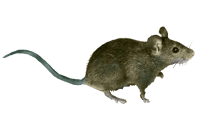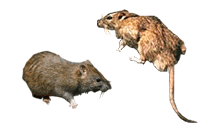Rid your home of unwanted pests with guaranteed service from Eagle Pest Control.
Eagle’s pest control maintenance service is designed to keep you home pest-free by creating a protective barrier around the exterior of your home. We use extremely effective, long-lasting products that are safe to use in homes, schools, day cares, and food service establishments. Our full-service maintenance plans are inclusive of all general household pests. You will have a pest-free environment, both inside and outside of your home or business – Guaranteed.For Service calls and pricing, please call 502-243-1600
Rodents

Deer Mouse
The deer mouse is common in rural areas, and occasionally found in suburban settings near rustic settings. Recently they have become a concern because they are carriers of hantavirus, which can be spread to humans. They are also a host for ticks that carry Lyme disease. They live both indoors and out, with cold weather causing them to come indoors more often. Deer mice are around 6" long, with half of the length being the tail.
They are colored gray to brown on the top half of their body and tail, with a white underside. Nests are in the ground, in stumps, or sheltered areas outside. When they move inside, nests can be in boxes, furniture, or in house voids.
Whether their nests are inside or out, they will be lined with whatever soft materials are available. Sometimes shredded items are evidence of this mouse scavenging for nesting material. Droppings are present in the nest, and urine close by. This practice causes deer mice to make new nests when the old ones are too soiled.
Like other mice, they can climb very well and get into all sorts of areas. They can contaminate food, and destroy property by nesting. Things in your home, or even electrical wires can be chewed on. Being desirable prey, they are nocturnal and secretive. Some things they eat include nuts, seeds, fruits, or insects. These foods are placed in caches in various places for later consumption.

House Mouse
The house mouse is very similar in size an appearance to the deer mouse, but is more adapted to thriving in indoor environments. House mice are around 6" long, with half their length being their tail. Coloration is gray or brown, with a light colored belly. The best way to distinguish this mouse from the deer mouse is the tail. The house mouse's tail is solid colored, while the deer mouse has a distinctly two-toned one.
House mice are more common, and considered a more significant pest. Preferred nesting sites are dark, secluded areas inside. Nests are usually built from shredded or scavenged household materials. Being rapid breeders, and actively foraging for food gives these mice the potential to become a great nuisance. They are acrobats with the ability to gain access through incredibly small holes, jump long distances, and climb almost anything.
They are mostly nocturnal, and constantly exploring new things. Items they wish to explore can have gnaw marks on them, especially if there is food inside. Droppings will also be present, concentrated mostly by feeding areas.
Contamination of food, and spreading of disease are associated with these mice. Various diseases such as Salmonella are spread through mice droppings and/or urine.

Norway/Sewer/Wharf Rat
The Norway rat is also referred to as the sewer rat, wharf rat, or brown rat. They can swim, and do inhabit sewers. It's the largest of rats and mice, with a body of around 8" long and a tail around 7". Their coarse fur is colored various shades of brown and black, with a lighter colored belly. The overall appearance of them can be described as stocky.
They are efficient breeders, with the ability to multiply fairly rapidly. Nesting sites are usually in the ground. Burrows are dug in the ground, or in piles of rubble. Burrows consist of a main opening, and at least one escape hole somewhere else. Sometimes nests are built in basements or in stored items that are left undisturbed. But they tend to stay away from higher altitudes in the home.
These rats get into food items inside and contaminate them, similar to mice with their feces and urine. They will eat almost anything, but prefer foods like meats, dog food, and cereals over vegetable matter. Rats spread many different types of diseases that are transmittable to humans. In addition they can cause unsightly damage to your home through gnawing, and greasy rub marks from their fur.

Roof/Black/Ship Rat
Roof rats, also called black rats or ship rats, are smaller in size than Norway rats. The roof rat has soft hair, in contrast to the Norway rat's coarse hair They are around 7" long, with a tail around 8" long. Coloration is a mixture of brown and/or black above, with a sometimes (but not always) lighter belly. Another way to distinguish roof rats from Norway rats is in the face.
Roof rats have a more pointy face, with larger eyes and ears. Droppings of the roof rat have pointy ends, whereas Norway rat droppings are rounded on the ends. The name roof rat probably referrs to their preference for higher places in structures and in trees outside. Although sometimes they will nest in basements or burrows underground. This rat shares many common behaviors of other rats.
They will destroy items through gnawing, leave greasy rub marks along their pathways, and contaminate food with feces and urine. Foods that they tend to preferr are fruits, vegetables, and cereals - but they will eat other things occasionally.
Additional resources are available to assist you in identifying and controlling insects.
Insect Identification
With over 1 million identified species of insects and spiders in the world with many more still awaiting discovery. Use Insect Identification categories to discover your species.
Pest World
For expert pest control tips and resources surf to Pest World.
Pest World for Kids
For fun pest facts and kid-friendly bug and insect research, head to Pest World for Kids.
